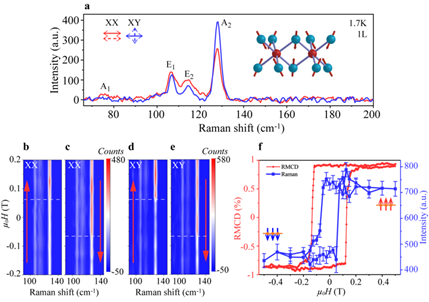Research by physicists at Southern University of Science and Technology has found a vital new relationship between Raman scattering and magnetic order in two-dimensional ferromagnetic materials.
Department of Physics Associate Professor Mingyuan Huang and Associate Professor Yue Zhao have worked together to advance scientific progress in two-dimensional magnetic insulators. High-impact journal Nano Letters published their paper on the topic under the title, “Magnetic Order Induced Polarization Anomaly of Raman Scattering in 2D magnet CrI3.”
Two-dimensional (2D) magnetic materials have many unique physical properties that lend themselves to a broad set of commercial applications. Chromium triiodide (CrI3) thin films have a weak anti-ferromagnetic interaction between layers, which allows for control by influences such as an external magnetic field, electrical field, doping, or pressure. It means they have significant potential for commercial purposes such as magnetoelectric storage, spin filtering, and spin transistors.

Fig. 1: the change of polarized Raman spectrum of single-layer CrI3 in magnetic field
The symmetry of the crystalline lattice is a majority determinant of the Raman scattering properties of phonons. The research team found that the magnetic order has a huge influence of Raman scattering in CrI3 than previously hypothesized.
After dropping the temperature of single-layer CrI3 to below the Curie temperature (the temperature where a long-range ferromagnetic order is formed), they found that Raman scattering was abnormally stronger in perpendicular direction. When they applied an external magnetic field to the single-layer CrI3, thereby flipping the spin direction, the scattering intensity experiences an abrupt change.
For bi-layer CrI3 samples, the dominant Raman mode exhibited Davydov splitting at temperatures below the Curie temperature. However, an external magnetic field would eliminate the Davydov splitting by tuning the bi-layer CrI3 from anti-ferromagnetic to ferromagnetic state. Their research has shown for the first time that Raman scattering is closely related to time-reversal symmetry.

Fig. 2: the polarized Raman spectrum of double-layer CrI3 changes with the magnetic field
SUSTech doctoral candidates Yujun Zhang and Xiaohua Wu were the co-first authors of the paper. Associate Professor Mingyuan Huang and Associate Professor Yue Zhao were the correspondent authors. Units involved in the research were the SUSTech Department of Physics, the Shenzhen Institute of Quantum Science and Engineering at SUSTech, the School of Advanced Materials at Peking University Shenzhen Graduate School, the Advanced Materials Laboratory at the National Institute for Materials Science (Japan), and the State Key Laboratory of Applied Surface Physics & Department of Physics at Fudan University.
The research received funding and support from the Key-Area Research and Development Program of Guangdong Province, the National Natural Science Foundation of China, the Guangdong Innovative and Entrepreneurial Research Team Program, the Shenzhen Municipal Science and Technology Innovation Commission, and the Shenzhen Municipal Industry and Information Technology Bureau. The Center for Computational Science and Engineering supported the computational needs of the research.
Paper link: https://pubs.acs.org/doi/full/10.1021/acs.nanolet.9b04634
Proofread ByXia Yingying
Photo ByDepartment of Physics, Qiu Yan